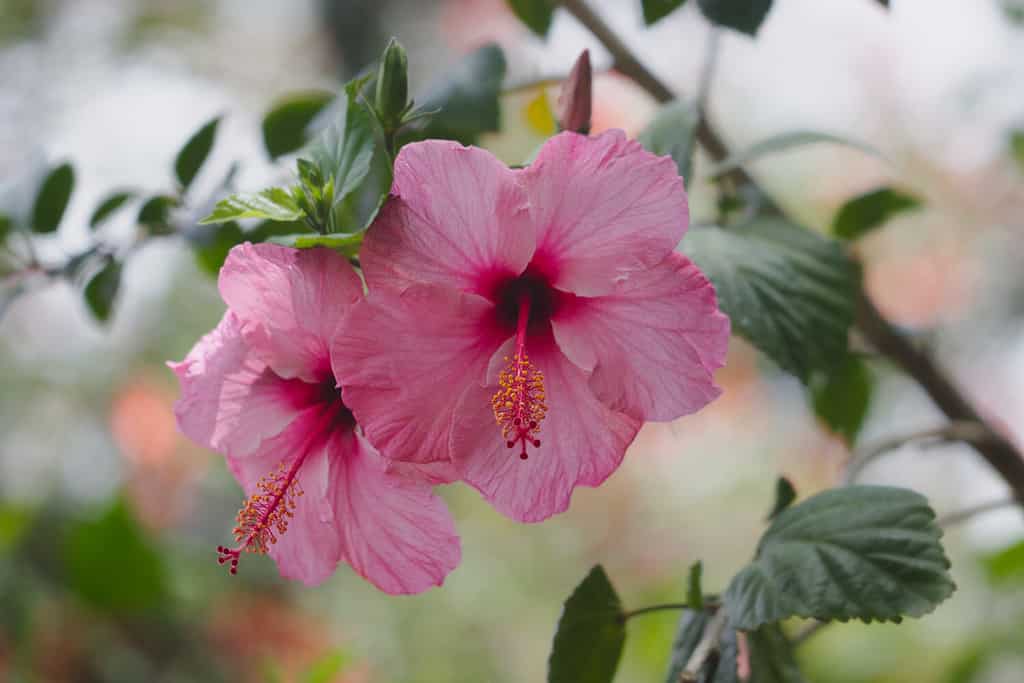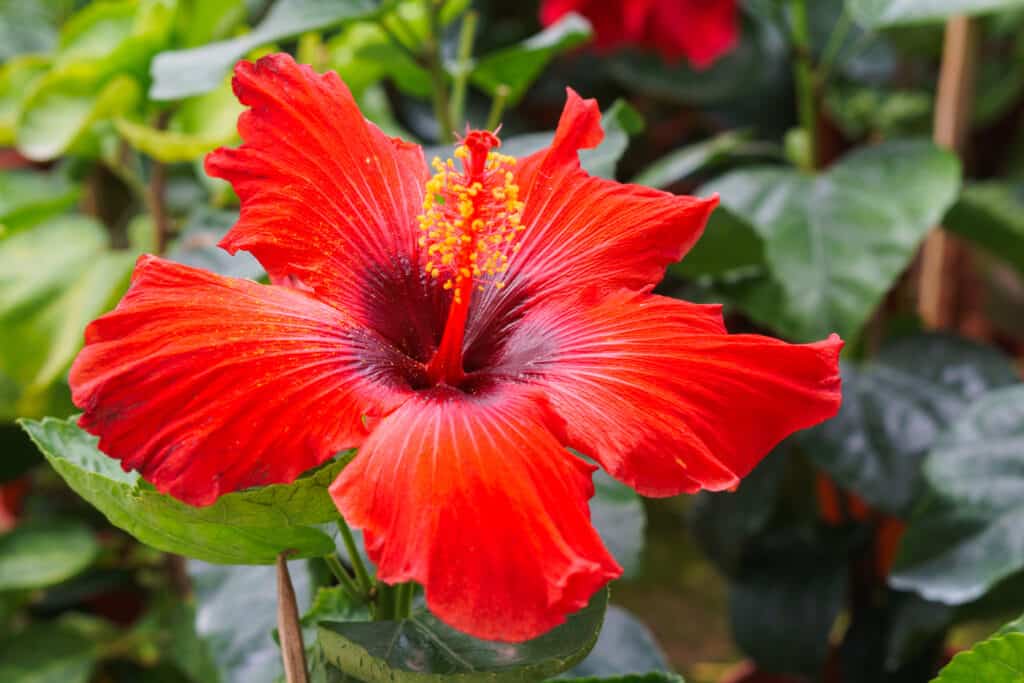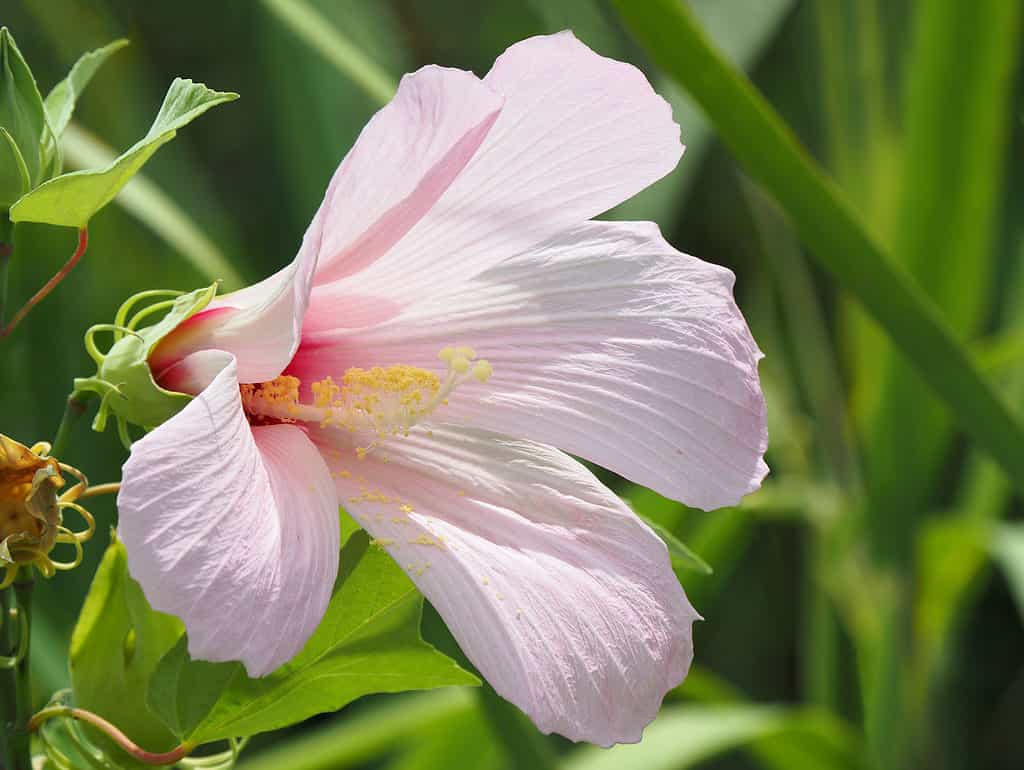Hibiscus flowers have large and vibrant standout blooms with a tropical style. There are hundreds of hibiscus varieties, some with differing peak seasons. When do hibiscus plants bloom where you live? The short answer is that hibiscus plants bloom in the summer in most climates. And a tropical hibiscus can bloom year-round in tropical regions.
However, to properly answer the question of when hibiscus plants bloom depends on knowing a few important factors:
- Whether the plant is a hardy hibiscus vs. tropical hibiscus
- The growth habit of the specific cultivars that you plant
- Your local climate and Hardiness Zones
Healthy hibiscus plants keep blooming for many weeks. But each hibiscus flower lasts only 1-3 days, depending on the variety.
The key to long-blooming hibiscus plants is to help them keep producing new blooms all season long. How do you do that? Keep reading to find out how to prolong the hibiscus flowering season after we discuss some common hibiscus plant types and their peak season by Zone.

Hardy hibiscuses usually bloom from mid-summer to early fall, depending on the plant variety.
©matunka/Shutterstock.com
Peak Hibiscus Season By Zone
Need a quick reference for hibiscus peak seasons by Zone? Look no further than the handy table below!
For those new to new to Hardiness Zones info, here’s a quick explanation of this handy mapping system. The USDA Hardiness Zone map separates the country into regions by climate. More specifically, these Hardiness Zones pinpoint the lowest average annual temperatures in each region.
The USDA Hardiness Zones map helps growers decide if certain plants, like hibiscus, can thrive in their local climate and survive the winter.
The following table shows general bloom timing for hibiscus plants in the U.S. Later, we’ll look at some of the most popular hibiscus plant types and their specific bloom timing.
| Hardiness Zones | Hibiscus Peak Season |
|---|---|
| Zone 2a-2b | Not recommended as a plant for this Zone, though potted hibiscus grows well indoors. |
| Zone 3a-3b | Not recommended as a plant for this Zone, though potted hibiscus grows well indoors. |
| Zones 4a-4b | Late summer through early fall |
| Zones 5a-5b | Late summer through early fall |
| Zones 6a-6b | Late summer through early fall |
| Zones 7a-7b | Late summer through early fall |
| Zones 8a-8b | Late summer through early fall |
| Zones 9a-9b | Late summer through early fall, though tropical hibiscus will bloom multiple seasons in Zone 9 |
| Zones 10a-10b | Blooms appear periodically year-round |
| Zones 11a-11b | Blooms appear periodically year-round |
Note that only hardy hibiscus plants survive winter in Zones 8 and lower. So, it’s important to know if you’re growing a tropical hibiscus or a hardy variety.

Tropical hibiscuses can bloom year-round in tropical climates.
©Cadurn/Shutterstock.com
Tropical vs. Hardy Hibiscus Plants
There are two main varieties of hibiscus shrubs: tropical and hardy.
Tropical hibiscus
This type of hibiscus is only hardy in warmer climates, including USDA Hardiness Zones 9 and above. Tropical hibiscus typically blooms year-round in Zones 10–11 but can depend on the cultivar. For example, a red-leaf hibiscus is a tropical variety but only blooms in summer and early fall.
Hardy hibiscus
These are the hardiest plants that can survive cold winters during their dormant phase and come back again the next growing season. Hardy hibiscus plants usually bloom between mid-summer and early fall in Zones 4-9. However, this timing can vary slightly between different cultivars.
There are many types of tropical and hardy hibiscus plants. Keep reading to discover some of the most popular varieties and their bloom timing.

Hibiscus blooms usually last only one day. However, some modern hybrids may last a day or two longer.
©Nuttapong Wongcheronkit/Shutterstock.com
Types of Hibiscus and Their Bloom Timing
Hibiscus plants produce showy flowers in bright colors like red, pink, orange, and yellow. There are single or double-petal varieties, plus different petal shapes like ruffled or fringed.
Hibiscus blooms can range in size from 4 inches across to massive 12-inch flowers, depending on the plant variety. Dynamic hibiscus flowers also attract pollinators like hummingbirds, bees, and butterflies.
Take a scroll through some fascinating types of tropical and perennial hibiscus plants below to learn their bloom timing. We hope this list helps you determine which hibiscus plants interest you and would grow well in your Hardiness Zone.
Comfortroot (Hibiscus aculeatus)
- Blooms late spring through the first autumn frost in Zones 7–10
- A hardy perennial wildflower shrub that thrives in wetlands
- Also called pineland hibiscus and big thicket hibiscus
Confederate Rose (Hibiscus mutabilis)
- Blooms late summer through early fall in Zones 7–11
- A perennial shrub or small tree with color-changing blooms that open white and mature to pink
Fringed Hibiscus (Hibiscus schizopetalus)
- Blooms at irregular intervals throughout the year in Zones 10–12
- An evergreen or semi-evergreen perennial shrub with fringed, pendulous blooms
- Also called Japanese lantern or Japanese hibiscus
Hawaiian White Hibiscus (Hibiscus aculeatus)
- Blooms all year in Zones 9–11
- A tropical evergreen shrub or small flowering tree
- One of only two hibiscus species with fragrant blooms
Mao Hau Hele (Hibiscus brackenridgei)
- Blooms consistently from late winter to late spring (then inconsistently summer through mid-winter) in Zones 9–11
- This hibiscus is a tropical shrub or small tree
- Also called the native yellow hibiscus, Mao Hau Hele is Hawaii’s state flower
Okra (Abelmoschus esculentus)
- Blooms early to late summer in Zones 2–11
- A tropical herbaceous annual in the hibiscus family that grows well in a wide range of Hardiness Zones, unlike other tropical plants
- Edible fruit pods develop behind spent blooms and are ready to harvest from late summer to early fall
Red-leaf Hibiscus (Hibiscus acetosella)
- Blooms infrequently between late summer to early fall in Zones 9–10 but provides garden interest with its reddish leaves all year long
- A tropical and herbaceous perennial with reddish mahogany leaves
- Note that red-leaf hibiscus can have a relatively short peak season for a tropical plant, even in tropical Zones
- Also called African rose mallow and cranberry hibiscus
Rose Mallow (Hibiscus moscheutos)
- Blooms mid-summer to early fall in Zones 4-9
- A hardy, herbaceous perennial shrub
- Also called dinner plate hibiscus, swamp rose mallow, common rose mallow, swamp mallow, marshmallow hibiscus
Rose of Sharon (Hibiscus syriacus)
- Blooms from mid-summer to early fall in Zones 5-9
- A hardy deciduous perennial shrub also called Syrian hibiscus
Sunset Muskmallow (Abelmoschus manihot)
- Blooms from mid-summer to early fall in Zones 8–10
- A tropical perennial shrub with up to 6-inch blooms
- Also called sweet hibiscus and edible hibiscus
Unfortunately, every type of hibiscus can become a non-blooming plant if it doesn’t get the proper care. So, let’s discuss reasons your hibiscus might not produce the gorgeous flowers they should.

Hibiscus shrubs need plenty of water and sunshine to bloom all season long.
©MajestiX B/Shutterstock.com
Why didn’t my hibiscus plants bloom?
Are your hibiscus shrubs underperforming in the bloom department? There are several reasons hibiscus plants don’t bloom, but many of them have easy fixes. Here are four common reasons your hibiscus might not produce flowers and what to do to bring those blooms back.
Not Enough Sun
Hibiscuses are not shade-loving plants. So, if your plants aren’t getting at least 6 hours of direct sunlight every day, that could be the main reason they aren’t providing any blooms.
The easy fix here is to replant hibiscus shrubs in a sunnier location. However, take a little extra care with the transplanting process. A hibiscus planted in a hole that’s too deep could develop root rot, so make sure the repositioned soil is level with the undisturbed ground surrounding the plant.
Too Much Fertilizer
Hibiscus plants can benefit from fertilizer, but they don’t benefit from receiving too much nitrogen. The excess nitrogen forces hibiscus shrubs to produce more foliage than blooms.
To prevent nitrogen overload, test your soil first for its pH balance. Hibiscus plants generally prefer soil with a pH between 6.5 and 7.0. Knowing the soil pH will help you determine which fertilizer is best to either raise or lower the soil acidity and nutrient content for your hibiscus plants.
Not Enough Water
We probably should have listed this reason for a non-blooming hibiscus first because hibiscus plants need loads of water! So if your flowering shrubs aren’t blooming, a lack of enough water could be a cause.
Keep hibiscus soil moist by watering the plants often. And new hibiscus shrubs should get water daily until the plants establish themselves in the soil.
If you notice that buds and blooms are falling off your hibiscus plants, you may be giving them too much water. You want to keep the hibiscus from drying out without drowning them in soggy dirt.
Not Enough Space to Grow
Depending on the variety and cultivar, hibiscus shrubs can grow from 4-16 feet tall. This fact is why hibiscus are also classified as small trees. So, a hibiscus that doesn’t have enough room to spread might not provide you with as many flowers.
Base how much space you give your hibiscuses on the growing guidelines for each specific cultivar.
For example, the Hibiscus x “Cherry Choco Latte” (rose mallow, hardy hibiscus) with pink and white blooms grows up to 4 feet tall and wide.
On the other hand, the H. syriacus “Ardens” (Rose of Sharon) with lavender-pink blooms grows up to 10 feet tall and wide.

The peak season for hibiscus blooms can vary between plant varieties and climate conditions.
©Bonnie Taylor Barry/Shutterstock.com
How To Prolong Hibiscus Blooms
Many hibiscus plants produce blooms that last only one day. Not much can be done about that other than to plant newer hybrids with blooms that last 1-3 days.
The good news is that healthy hibiscus plants will keep on blooming for many weeks during the growing season. So keep your plants healthy to watch them pop with new colorful flowers day after day!
Here’s a quick reminder of how to grow healthy hibiscus shrubs that produce many blooms all season:
- Grow hibiscuses in sunny areas with at least 6 hours of sunlight per day.
- Water these shrubs often for moist but not soggy soil.
- Test soil pH before fertilizing to ensure hibiscus plants don’t get too much nitrogen from fertilizers. Your soil pH should be over 6.5 and under 7.0 for optimal hibiscus health.
- Give hibiscus plants plenty of space to grow. Remember that some plants grow much bigger than others, so base the growing space on the specific cultivar’s needs.
- Keep in mind that many hibiscus shrubs start showing signs of life (new growth) later in spring than many other plants, so don’t give up on them!

Gardeners can grow tropical hibiscus plants in colder Zones as annuals for one bloom season.
©Steve Bower/Shutterstock.com
When hibiscuses bloom in your garden, enjoy the tropical show!
A hibiscus in bloom is a magnificent sight, even if you don’t live in a tropical climate. But knowing the variety of hibiscus you’re growing is essential for determining its peak season by Hardiness Zone. So mark your calendar for the dates that your hibiscuses should bloom in your local climate and enjoy the tropical splendor!
No matter when hibiscus plants bloom in your region, these shrubs constantly replenish with new short-lived flowers. Keep these plants healthy to enjoy a full season of colorful blooms.
The photo featured at the top of this post is © Islandgyrl Studios/Shutterstock.com
Thank you for reading! Have some feedback for us? Contact the AZ Animals editorial team.







